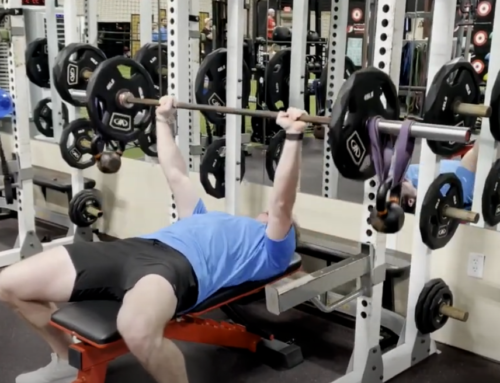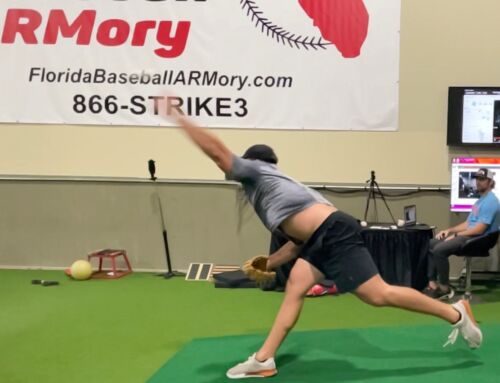
Which is best, the traditional swing or the kickback swing?
By Dom Anagnos, BATtery Power Hitting System Coordinator
With Randy Sullivan, MPT, CSCS, CEO, Florida Baseball ARMory
 This question is debated incessantly in the hitting world.
This question is debated incessantly in the hitting world.
Our answer at the BATtery is a resounding, “Yes.”
 During tight turns in agility, we see two different rotation types involving the pelvis and shoulders, real rotation and false rotation—both aid in transferring energy from the lower body to the upper body. Hitting is a complex movement with a lot of moving parts. Ultimately all the moving parts need to propel that bat forward in a coordinated spot to hit a moving baseball. Good hitters establish stability with their lower half to adjust to their perception. Pelvic and core stability puts them in good positions to optimize rotation through the abdominals catapulting the shoulders, arms, and the bat (proximal to distal).
During tight turns in agility, we see two different rotation types involving the pelvis and shoulders, real rotation and false rotation—both aid in transferring energy from the lower body to the upper body. Hitting is a complex movement with a lot of moving parts. Ultimately all the moving parts need to propel that bat forward in a coordinated spot to hit a moving baseball. Good hitters establish stability with their lower half to adjust to their perception. Pelvic and core stability puts them in good positions to optimize rotation through the abdominals catapulting the shoulders, arms, and the bat (proximal to distal).
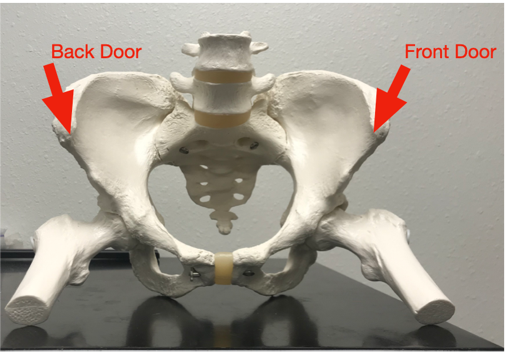 The pelvis is a crucial piece of the puzzle, especially in complex movements like hitting. ARMory CEO, Randy Sullivan even calls it “the center of the universe.” A good visualization for the pelvis is to imagine it has a front door and a back door. For a hitter, the front door would be the lead side of the structure closest to the pitcher, and the back door would be the opposite side closest to the catcher.
The pelvis is a crucial piece of the puzzle, especially in complex movements like hitting. ARMory CEO, Randy Sullivan even calls it “the center of the universe.” A good visualization for the pelvis is to imagine it has a front door and a back door. For a hitter, the front door would be the lead side of the structure closest to the pitcher, and the back door would be the opposite side closest to the catcher.
 Every player’s anatomy is slightly different. We call this the hardware (how the player is built). The player’s hardware can positively or negatively affect his software (movement choices) and vice versa.
Every player’s anatomy is slightly different. We call this the hardware (how the player is built). The player’s hardware can positively or negatively affect his software (movement choices) and vice versa.
Some hardware traits can be changed, and some can’t. For example, if a player has tight hamstrings, a regular stretching program might lengthen his muscles. However, bony 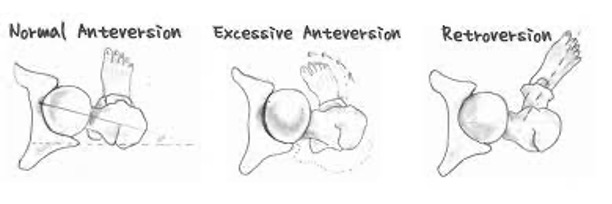 characteristics are often fixed and unalterable. Let’s consider the bony orientation of the hips. Some athletes have hip sockets positioned toward the back of the pelvis and pointing outward. The medical term is “retroverted hips.” Players with retroverted hips tend to stand with their feet pointing outward. They can sit comfortably on the floor with their legs crossed. They prefer external rotation of their hips but can’t consistently achieve a lot of internal rotation (especially when they are on their feet). In contrast, athletes with “anteverted hips” (positioned forward and pointing inward) tend to stand pigeon-toed and cross-legged. They are usually uncomfortable sitting cross-legged on the floor, and they prefer internal rotation to external.
characteristics are often fixed and unalterable. Let’s consider the bony orientation of the hips. Some athletes have hip sockets positioned toward the back of the pelvis and pointing outward. The medical term is “retroverted hips.” Players with retroverted hips tend to stand with their feet pointing outward. They can sit comfortably on the floor with their legs crossed. They prefer external rotation of their hips but can’t consistently achieve a lot of internal rotation (especially when they are on their feet). In contrast, athletes with “anteverted hips” (positioned forward and pointing inward) tend to stand pigeon-toed and cross-legged. They are usually uncomfortable sitting cross-legged on the floor, and they prefer internal rotation to external.
When it comes to adjusting to pitches inside, middle, and away, the pelvis’s rotation needs to be extremely precise. The pelvis needs to rotate roughly 90 degrees for an inside pitch to clear the hips and propel the bat to make solid contact out front. For the middle pitch, the pelvis can rotate a little less because the contact point is a little closer, and on the outside pitch, the pelvis can rotate even less.
The athlete needs to stop (or at least slow down) pelvic rotation to send energy up to the abdominals through the kinetic chain. Stopping the pelvis invites the energy to move through the upper body, propelling the bat head out front for contact. False rotation is a way of stopping the pelvis abruptly, sometimes to the point where it even counter rotates.
If stopping pelvic rotation is a critically precise adjustment, then why do some hitters do it differently?
Why do some hitters kickback and others don’t?
Hitters can stride in three directions: toward home plate, toward the pitcher, or away from home plate. The orientation of their hips, thoracic rotation mobility, and pitch location and speed all factor into a movement solution. For example, a hitter with retroverted hips striding slightly open or straight with average thoracic mobility will be able to clear their hips to meet the ball out front. If this same retrovert strides towards home plate, closing themselves off, they will need to compensate for the rotation of their pelvis to clear their hips and propel the bat forward. Two different scenarios can lead the same hitter to two markedly different swings.
On the other hand, an antevert that strides towards the plate can comfortably clear the hips and get the upper body to move through the zone to meet the ball out front. However, if the antevert strides slightly open, they might put themselves in an uncomfortable position to rotate, leading them to difficulty transferring energy through the abdominals to get the bat to the ball.
Understanding that hip orientation, thoracic mobility, stride direction, pitch location, and speed all play a factor in the hitter’s choice of movement strategy, let’s dive deep into the technical aspects of real and false rotation.
Real rotation occurs when the pelvis rotates first, and the shoulders lag behind. The hitter gathers elastic tension through the abdominals before unloading it and allowing the shoulders to rotate in the same direction, creating a catapult effect to propel the bat through the zone.

Real Rotation: Outside Fastball, Middle Fastball, Inside Fastball all hit for home runs. More pelvis rotation as the pitch moves towards Aaron Judge to clear and propel the upper body out front towards the baseball.
In false rotation the front door of the pelvis stops and reverses course (counter-rotating) to propel the bat forward. The hitter’s rear leg kicks back to find stability. The kickback tilts the pelvis slightly anteriorly or posteriorly, keeping the abdominals near their optimal lengths. The greater the false rotation, the bigger the kickback.

False Rotation: Outside Fastball, Middle Fastball, Inside Fastball all hit for home runs. The greater the kickback the less the back door of the pelvis needs to travel to clear and propel the upper body towards the baseball.
Real rotation and false rotation movement solutions should be a part of every hitter’s toolbox, but they aren’t binary options. Real vs false rotation is a continuum influenced by the athlete’s hardware and the pitch’s speed, location, and movement. A wide array of swing options can improve the adaptability of a hitter. The goal is to create an environment in practice to pressure the hitter and guide him to the best movement solution for any pitch he might see. If done right, hitters are free to explore real and false rotation movement solutions anywhere on the movement spectrum.
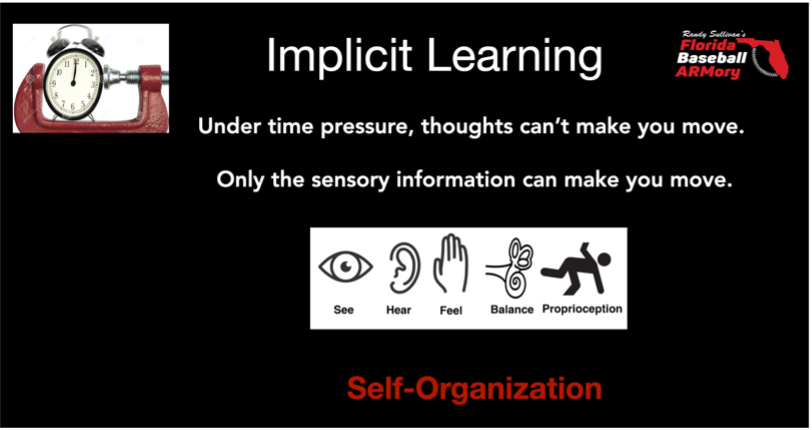 At The BATtery, perhaps the best part of the whole process is that we teach implicitly. A hitter doesn’t have time to consciously organize and control a swing. When a hitter is under time pressure, only the sensory information he gathers can influence his movement. Training a hitter with verbal cues and excessive cognitive input is usually a recipe for disaster. At The BATtery, we teach movement implicitly by immersing our students in a sensory experience that subconsciously changes the way they move. Implicitly learning both real and false rotation swings is a game-changer. It adds an entirely new category of tools to a hitter’s tool belt, which increases his chances of finding success in complex environments like the game.
At The BATtery, perhaps the best part of the whole process is that we teach implicitly. A hitter doesn’t have time to consciously organize and control a swing. When a hitter is under time pressure, only the sensory information he gathers can influence his movement. Training a hitter with verbal cues and excessive cognitive input is usually a recipe for disaster. At The BATtery, we teach movement implicitly by immersing our students in a sensory experience that subconsciously changes the way they move. Implicitly learning both real and false rotation swings is a game-changer. It adds an entirely new category of tools to a hitter’s tool belt, which increases his chances of finding success in complex environments like the game.
Real rotation and false rotation are viable options that can contribute to success at the plate, but they offer different advantages and associated vulnerabilities. Real rotation affords the hitter more  adjustability, but it demands the hitter be on time (early and adjustable). Early allows the hitter time to adjust to the sensory information received from the pitcher and ball flight. When a hitter executes a real rotation swing, he earns time and space to adjust to different pitch speeds and locations. If his adjustment fails, or he finds himself off time, he can resort to an emergency kickback swing and salvage the result. The false rotation also has its benefits, especially when facing high velocity. With the pelvis counter-rotating, the hips don’t need to clear as far, allowing a hitter to make contact a little later. We view the false rotation as a late and sudden emergency option. It often emerges in two-strike situations or when facing elite velocity. It does, however, come at the expense of some adjustability. In Major League Baseball, pitchers are throwing harder every year, so we believe more and more hitters at the pro level use this false rotation swing.
adjustability, but it demands the hitter be on time (early and adjustable). Early allows the hitter time to adjust to the sensory information received from the pitcher and ball flight. When a hitter executes a real rotation swing, he earns time and space to adjust to different pitch speeds and locations. If his adjustment fails, or he finds himself off time, he can resort to an emergency kickback swing and salvage the result. The false rotation also has its benefits, especially when facing high velocity. With the pelvis counter-rotating, the hips don’t need to clear as far, allowing a hitter to make contact a little later. We view the false rotation as a late and sudden emergency option. It often emerges in two-strike situations or when facing elite velocity. It does, however, come at the expense of some adjustability. In Major League Baseball, pitchers are throwing harder every year, so we believe more and more hitters at the pro level use this false rotation swing.
Most hitters start with a real rotation swing. The back foot is anchored in the ground and provides friction to aid in pelvic rotation to transfer up the kinetic chain.

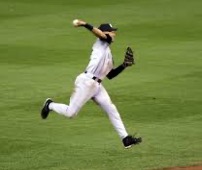 In other sports like hockey, volleyball, and water polo, the athlete doesn’t have the luxury of anchoring the back foot, which forces them to deploy the false rotation option.
In other sports like hockey, volleyball, and water polo, the athlete doesn’t have the luxury of anchoring the back foot, which forces them to deploy the false rotation option.
Similarly, the famous backhand Jeter jump throw is a false rotation. The ground is not aiding rotation so false rotation gathers and transfers energy.
Real and False Rotation Swing Examples:
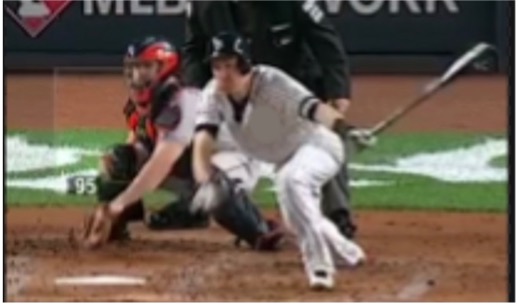 Let’s say a hitter is on time for the fastball but instead gets the changeup. When their front foot finds the ground too early, they must find a way to keep their energy held back to match the delayed baseball. The kickback is a great option here. Kicking their foot back anteriorly tilts the pelvis forward slightly. They sink in their legs, momentarily delaying the transfer through the abdominals up the chain. In essence, they use the kickback to reset their timing and regain a stable platform from which they can launch the barrel to the baseball.
Let’s say a hitter is on time for the fastball but instead gets the changeup. When their front foot finds the ground too early, they must find a way to keep their energy held back to match the delayed baseball. The kickback is a great option here. Kicking their foot back anteriorly tilts the pelvis forward slightly. They sink in their legs, momentarily delaying the transfer through the abdominals up the chain. In essence, they use the kickback to reset their timing and regain a stable platform from which they can launch the barrel to the baseball.
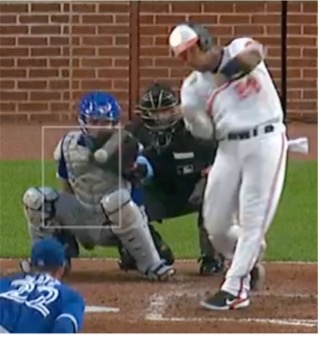 Suppose a hitter that is late, say on a 2-seam fastball that runs inside, they can make up time with a false rotation. By kicking their back foot and holding the pelvis in a more neutral or slightly posteriorly tilted position, the hitter can create time and space to transfer energy up and get a barrel inside the baseball.
Suppose a hitter that is late, say on a 2-seam fastball that runs inside, they can make up time with a false rotation. By kicking their back foot and holding the pelvis in a more neutral or slightly posteriorly tilted position, the hitter can create time and space to transfer energy up and get a barrel inside the baseball.
 A great example is Fernando Tatis Jr, a notorious kickback swing guy that may have developed this false rotation swing due to the extreme velocities of pitchers nowadays. But that’s not the only way he swings. We found this video of Tatis Jr. using a real rotation swing while hitting a grand slam against the Houston Astros. Do you think he consciously thought before the pitch “I’m going to real rotate this time?” Or was it the environment that dictated his movement? When he was on time for what he anticipated he used a movement solution of real rotation to attack the baseball.
A great example is Fernando Tatis Jr, a notorious kickback swing guy that may have developed this false rotation swing due to the extreme velocities of pitchers nowadays. But that’s not the only way he swings. We found this video of Tatis Jr. using a real rotation swing while hitting a grand slam against the Houston Astros. Do you think he consciously thought before the pitch “I’m going to real rotate this time?” Or was it the environment that dictated his movement? When he was on time for what he anticipated he used a movement solution of real rotation to attack the baseball.
Vlad Guerrero Jr is another superstar hit three home runs in a single game against the Yankees on 4/13/22. Two of which were home runs against arguably the best pitcher in the game right now Gerrit Cole. First home run utilizing a real rotation swing against a hanging breaking ball in which he was on time. The second home run was a fastball inside in which he kicked back to create time and space to get a barrel to the baseball. Vlad is another prime example of utilizing different rotational movement solutions to find a way to be successful in complex environments like the game.

Vlad Guerrero Jr vs Gerrit Cole 2 home runs: Left: Fastball inside, false rotation to create space and time to get a barrel inside. Middle: Bird’s eye view of False Rotation. Breaking ball middle: on-time real rotation swing.
We want our hitters to be adept at subconsciously deploying either option. Instead of predetermining which choice he’ll need, the appropriate solution emerges in response to the sensory information presented. With a false rotation swing in the tool belt, good hitters can be early or late and adjust to the time pressure problem.
So which swing pattern is better, real rotation or apparent rotation?
The answer is “Yes.”
Since every athlete is different and every pitch requires a unique movement solution, we teach them both. Matching the athlete’s hardware to his software is the first step. But we want our hitter’s movement toolbox to include a real rotation option for when he’s on time and afforded to be early and adjustable. He also needs a false rotation swing for emergencies, like when he faces upper-level velocity, has two strikes, or is fooled by an off-speed and needs to resort to a late and sudden solution.
If you’re ready to engage in a training process that helped Los Angeles Angels star, Jared Walsh (a 38th round draft pick) become a MLB All Star, The BATtery Power Hitting System is for you. Give us a call at 866-787-4533. We’ll get you set up with an individualized training process that loads you tool belt with a wide array of SAVAGE hitting options.
Let’s Get SAVAGE!
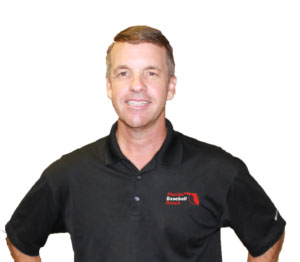
Randy Sullivan, MPT, CSCS CEO, Florida Baseball ARMory



